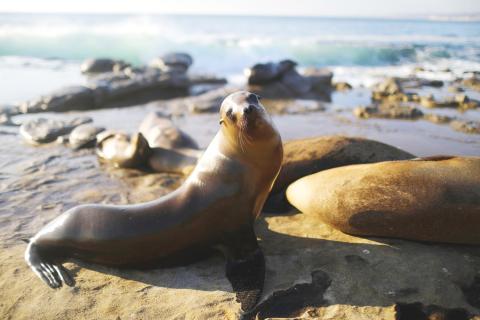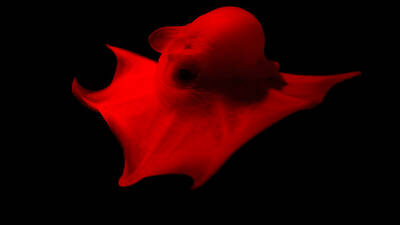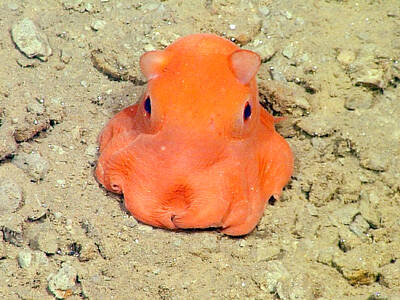Even the oceans are breaking temperature records in this summer of heat waves. Off the San Diego coast, scientists earlier this month recorded all-time high seawater temperatures since daily measurements began in 1916. “Just like we have heat waves on land, we also have heat waves in the ocean,” said Art Miller of the Scripps Institution of Oceanography.
Between 1982 and 2016, the number of “marine heat waves” roughly doubled, and likely will become more common and intense as the planet warms, a study released Wednesday found. Prolonged periods of extreme heat in the oceans can damage kelp forests and coral reefs, and harm fish and other marine life.
“This trend will only further accelerate with global warming,” said Thomas Frolicher, a climate scientist at the University of Bern in Switzerland, who led the research. His team defined marine heat waves as extreme events in which sea-surface temperatures exceeded the 99th percentile of measurements for a given location. Because oceans both absorb and release heat more slowly than air, most marine heat waves last for at least several days — and some for several weeks, said Frolicher.

Photo: AFP
照片:法新社
Many sea critters have evolved to survive within a fairly narrow band of temperatures compared to creatures on land, and even incremental warming can be disruptive. Some free-swimming sea animals like bat rays or lobsters may shift their routines. But stationary organisms like coral reefs and kelp forests “are in real peril,” said Michael Burrows, an ecologist at the Scottish Marine Institute.
In 2016 and 2017, persistent high ocean temperatures off eastern Australia killed off as much as half of the shallow water corals of the Great Barrier Reef — with significant consequences for other creatures dependent upon the reef. “One in every four fish in the ocean lives in or around coral reefs,” said Ove Hoegh-Guldberg, a marine biologist at the University of Queensland. “So much of the ocean’s biodiversity depends upon a fairly small amount of the ocean floor.”
The latest study in Nature relied on satellite data and other records of sea-surface temperatures including from ships and buoys. It didn’t include the recent record-breaking measurements off Scripps Pier in San Diego — which reached 26.39°C on Aug. 9 — but Frolicher and Miller said the event was an example of a marine heat wave. Miller said he knew something was odd when he spotted a school of bat rays — which typically only congregate in pockets of warm water — swimming just off the pier earlier this month.
Changes in ocean circulation associated with warmer surface waters will likely mean decreased production of phytoplankton — the tiny organisms that form the basis of the marine food web, Miller said. Marine biologists nicknamed a patch of persistent high temperatures in the Pacific Ocean between 2013 and 2016 “the Blob.” During that period, decreased phytoplankton production led to a cascading lack of food for many species, causing thousands of California sea lion pups to starve, said Miller.
“We’ve repeatedly set new heat records. It’s not surprising, but it is shocking,” he added.(AP)
在今年夏天的多重熱浪襲擊下,連海洋溫度都不斷打破紀錄。本月初,科學家在聖地牙哥近岸處,記錄到自一九一六年以來開始進行每日測量後的空前海水高溫。斯克里普斯海洋研究所的阿特‧米勒表示:「正如同我們陸地上有熱浪,海洋也無法倖免。」
週三發表的研究發現,在一九八二年到二○一六年間,「海洋熱浪」發生的次數大概成長了一倍,並且很有可能隨著地球暖化變得更為常見且劇烈。海洋中極端高溫的時間一旦延長,就會對海藻森林與珊瑚礁造成破壞,進而傷害魚類和其他海洋生物。
瑞士伯恩大學的氣候科學家托瑪斯‧佛洛里雪是該研究的主持人,他指出「這個趨勢只會隨著全球暖化進一步加劇。」該研究團隊將海洋熱浪定義為一種極端事件:意即一處固定地點的海面溫度,超過當地記錄測量值的第九十九個百分位數。佛洛里雪表示,由於海洋在吸收和釋放熱能時速度較大氣緩慢,所以大多數海洋熱浪都會持續好幾天──有時甚至持續數週。
比起陸地生物,許多海洋動物演化為只能在相當狹隘的溫度帶中生存,甚至連遞增的升溫都可能對它們造成威脅。某些能夠自由游泳的海洋動物──像是蝙蝠魟魚或龍蝦──或許會更動它們的日常習性,但蘇格蘭海洋研究所的生態學家麥可‧布洛斯指出,像是珊瑚礁或是海藻森林等固著性生物「眼下深陷險境」。
二○一六年和二○一七年,澳洲東部近海持續的海洋高溫已奪走大堡礁多達半數的淺水珊瑚,並為仰賴珊瑚礁而生的其他生物帶來嚴重後果。昆士蘭大學的海洋生物學家奧維‧赫格─古貝格表示「在海洋中,每四條魚中就有一隻生活在珊瑚礁中或於周圍棲息,海洋裡絕大部分的生物多樣性都仰賴面積相當狹小的海床生態。」
這份《自然》期刊上的最新研究使用衛星數據以及包括船隻和浮筒所記錄到的海面溫度。該研究雖未納入近日在聖地牙哥斯克里普斯碼頭外海觀測到的破紀錄數值──八月九號海面溫度高達攝氏二十六‧三九度──但佛洛里雪和米勒都認為這就是海洋熱浪的例證。米勒說,他在這個月稍早曾目擊到一群蝙蝠魟魚──通常只會聚集在溫暖的水域──在碼頭外游過,就知道情況不太對勁。
米勒表示,愈趨溫暖的表層水與海洋循環改變有關,遂可能導致浮游植物數量減少,而浮游植物卻是構成海洋食物鏈基礎的重要微生物。二○一三年到二○一六年間,太平洋上一塊持續高溫的範圍被海洋生物學家暱稱為「水泡」。米勒指出,在那段時期浮游植物產量減少,對眾多物種造成連鎖性食物匱乏,並導致加州數千隻幼小的海獅餓死。
米勒補充說:「我們不斷創下新的高溫紀錄,這並不讓人意外,而是令人震驚的。」
(台北時報章厚明譯)

A: In addition to “Mission: Impossible 8,” what other new movies are in theaters? B: “Final Destination: Bloodlines” and “The Wedding Banquet” are out. The French film “Jane Austen Wrecked My Life” will also open soon. A: The Final Destination horror movie series is so scary that I don’t dare watch it. B: Then how about “The Wedding Banquet,” which is a 2025 remake of the 1993 classic of the same title? Oscar-winning actress Youn Yuh-jung’s performance in it is highly anticipated. A: But as a fan of British writer Jane Austen, I’m more interested to see how her works

A: Wanna go see a movie during the three-day weekend for the Dragon Boat Festival? B: Sure, I wanna see “Mission: Impossible – The Final Reckoning.” A: Rumor has it that this may be actor Tom Cruise’s last mission with the Mission: Impossible action movie franchise. B: Tom was only 34 when the first installment of the series was released in 1996. Now, he’s 63 and the eighth installment is out. A: I hope he’ll stay with the series. Let’s go see him fight against AI this weekend. A: 端午節三天連假週末要不要去看電影? B: 好啊我想看 《不可能的任務:最終清算》! A: 這有可能是湯姆克魯斯最後一次為動作片《不可能》系列出任務。 B:

The deep waters off the coast of California are home to a bizarre creature: the flapjack octopus. This creature, known for its pancake-like appearance, spreads itself thin on the seabed as a clever survival strategy, making it difficult for predators to spot and capture it. With its unique, umbrella-shaped body formed by webbed arms, the flapjack octopus moves through the water in a graceful manner. It propels itself forward by rhythmically moving its body and contracting its webbed arms. Its pair of ear-like fins, which move independently yet with remarkable coordination, also help it explore the deep-sea environment. These

Continued from yesterday(延續自昨日) https://www.taipeitimes.com/News/lang Many people may be familiar with flapjack octopuses thanks to Pearl, a charming character from the Pixar film Finding Nemo. However, her portrayal presents several scientific inaccuracies. In reality, flapjack octopuses are deep-sea creatures, which are unsuitable for the brightly lit shallow reef environment depicted in the film. Their primary defense mechanism relies on their reddish coloration, which would be ineffective in the well-lit shallows. Pearl’s famous line, “You guys made me ink,” is another fictional detail that is not consistent with the observed actions of real flapjack octopuses. As common as it is in many other octopus